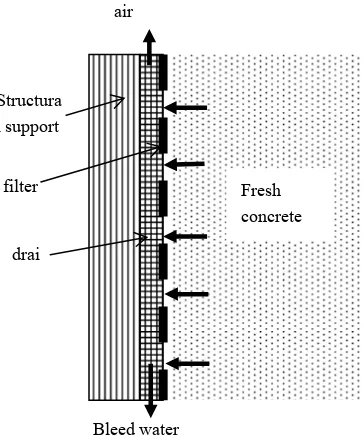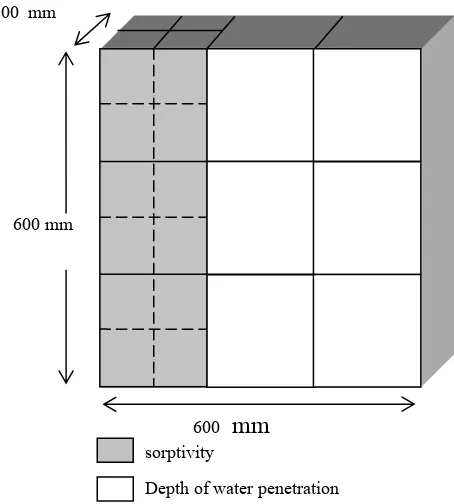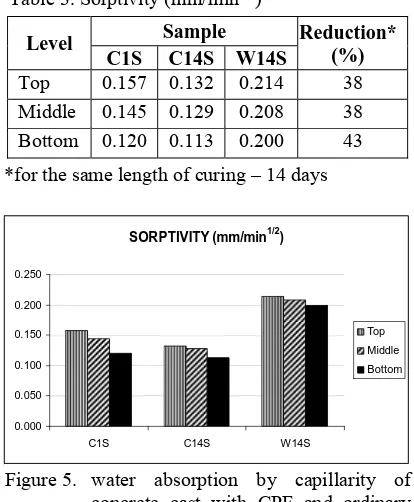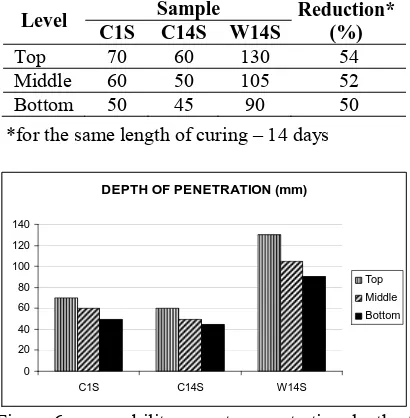THE EFFECT OF CONTROLLED PERMEABILITY FORMWORK
WITH DIFFERENT CURING METHODS ON THE DURABILITY
CHARACTERISTICS OF CONCRETE
Andi Arham Adam**
Abstract
Controlled Permeability Formwork (CPF) can be used to improve the strength, durability and appearance of concrete. This is achieved by allowing excess water and gas to escape at the surface adjacent to the formwork. This paper reports a study aimed at assessing whether such permeable formwork can be used to reduce curing times whilst maintaining durability and strength characteristics. An experimental study is described where trial walls are constructed and tested at various ages following different curing periods and regimes. Results are presented that compare the outcomes of using permeable membrane with those of using a traditional formwork. Comparisons of durability characteristics are were. The durability of the walls was assessed by techniques such as: permeability; and water absorption. Results are presented in terms of how different curing regimes can be employed to achieve equivalent characteristics. A discussion of how such techniques may be used to reduce construction time is presented.
Keyword: Controlled Permeability Formwork, permeability, absorption
*
Staf Pengajar Jurusan Teknik Sipil Fakultas Teknik Universitas Tadulako, Palu
1. Introduction
It is widely accepted that the surface zone is the major influence on the durability of concrete forming the first line of defense against either physical or chemical deterioration. Aggressive agents penetrate the concrete through the surface zone, thus the transport properties of this zone will determine the rate of penetration into the bulk of the concrete. However, the surface of the concrete is more vulnerable to poor curing and compaction than the bulk of the concrete in the heart of the section (Cairns, 1999). Therefore, a well-compacted strong concrete surface zone is needed with low permeability, low diffusivity and without map cracking. Also an adequate thickness of concrete cover to the reinforcement must be provided. Consequently by improving the permeation properties (absorption, permeability and diffusion) and the strength of the surface zone, one can expect to improve the durability of the whole concrete member.
Traditional approaches to improve the quality of the surface zone are to improve the performance of the bulk concrete by materials selection and controlling mix proportions, however
curing is also important and often difficult to control/achieve in practice. Controlled permeability formwork (CPF) is one of the recent developments to improve the quality of the surface zone of the concrete by allowing the bleed water and gas to escape from the concrete surface whilst retaining the cement particles resulting in a denser and less porous concrete surface. The technique reduces the near-surface water/binder ratio and reduces the sensitivity of concrete to poor site curing (Coutinho, 2003).
Although there are several types of CPF systems available on the market, all share the same general principles. According to Price (2000), the basic elements of any CPF system are as follows (Figure1).
− A filter that allows the passage of air and water from the fresh concrete but retains cement and other fine solids
− A drainage system that transfers the air and water removed from the fresh concrete to outside the formwork
200
Figure 1. General elements of a CPF system (Price, 2000)
Price (2000) classified the CPF system into three general classifications:
− Type I. Two-layer filter fabric systems that are fixed over a structural support and tensioned in- situ. These systems can be reused with careful cleaning between uses. Two CPF systems of this category are silk form and textile form
− Type II. A single-layer filter fabric system that is fixed over a structural support and tensioned in- situ. These systems are generally single-use products. Formtex and Zemdrain are examples of this type.
is one of this class.
The aim of the research carried out is to assess whether the controlled permeability formwork can be used to reduce curing times whilst maintaining durability and strength characteristics of concrete.
2. Experimental Details
2.1 Materials
General Purpose (GP) Cement, supplied by Cement Australia in according to AS 3972 (1997) was used in this study. The coarse aggregates used were natural river gravel with 10 mm maximum size, while the fine aggregates were natural river sand with 80% passing a 600 μm sieve. Both coarse and fine aggregates were prepared in accordance with AS 2758.1 (1998)
The controlled permeability formwork liner adopted was Formtex manufactured and marketed by Fibertex. The physical properties of the liner are shown in Table 1.
Three moulds of 200mm x 600mm x 600mm (high) made from Plywood were used in this experiment. Two moulds had CPF liner attached on the 600 x 600 face to form the Controlled Permeability Formwork system while the other mould was used as traditional formwork – offering a timber surface.
Table 1. Physical properties of Formtex (as provided by the manufacturer)
Physical properties Unit value
Pore size μm <30
weight g/m2 250
Air permeability at 800 Pa l/sec/m2 250
Tear strength machine direction N 250
Tear strength machine direction N 200
Thickness at 2 kPa mm 1.2
Composition 100% polypropylene
filter
drai
Fresh concrete
The Effect of Controlled Permeability Formwork with Different Curing Methods on The Durability Characteristics of Concrete
Figure 2. Specimen dimension, cutting positions and tests.
2.1 Mix proportion
The mix design in this experiment was based on the British Department of the Environment document (1988). The mix proportion are tabulated in Table 2.
Table 2. Proportions of the mix
Water 193 kg/m3
Cement 402 kg/m3
Coarse aggregate
10-mm 419 kg/m3
20-mm 838 kg/m3
Sand 532 kg/m3
2.3 Specimens details
Three specimens of 200mm x 600mm x 600mm (high) as shown in Figure 2. were cast in this experiment. Two specimens were cast with CPF whilst the other was constructed in traditional
formwork. The 2 character notation adopted is as follows:
− First character : C = CPF; W= Plywood
formwork
− The second character (a number and letter): 1S =1 day curing with wet hessian; 14S=14 days curing with wet hessian.
2.4 Mixing, curing, and cutting
The mixing was performed in accordance with AS 1012.2 (1994) using dry aggregate and a pan mixer. The fresh concrete was poured into the special moulds in three layers. After pouring, poker vibration was applied to each layer to assist the draining of the excess water through the CPF liner. The formwork was removed 24 hours after casting for all specimens. Two specimens (CPF and ordinary formwork) were then cured by covering them with wet hessian and polyethylene sheet for 14 days, the other CPF specimen was cured for 1 day. After the period of curing, the specimens were exposed to the laboratory environment. At the age
200 mm
600 mm
600
mm
sorptivity202
2.5 Test program
• Sorptivity test
The sorptivity tests were undertaken in accordance with DIN 52617 (1987). Samples of 100 x 100 x 100 mm were dried to a constant weight. The samples were weighed to obtain the dry weight of the sample and then immersed face down in water to a depth of 2-5 mm. The sides of the specimens were coated with epoxy to allow free water movement only through the bottom face (unidirectional flow). At intervals of 5, 10, 30, 60 minutes, and then hourly to 4 hours after the start of the test, the specimen was removed from the tray, the surplus water wiped off with tissue paper, and the specimen weighed to the nearest 0.1 g and then returned to the tray. The results were plotted against the square root of the time to obtain a slope of the best fit straight line.
According to Hall (1989), the penetration of water under capillary action can be modeled by:
It was found that the experimental data plotted against t1/2 was very well represented by a straight line with s (water sorptivity in mm/ min1/2) being the slope of the line. In this test program, Equation 1 was used to determine the water sorptivity of concrete by linear regression.
• Depth of water penetration
The depth of water penetration was assessed in accordance to DIN 1048 (1990) using a concrete impermeability apparatus (as shown Figure 3). Concrete samples were placed inside the permeability cells and a water pressure of 100kPa was applied to the samples for two days followed by 300kPa and 700kPa for one day each. At the end of this period, the test samples were removed from the cells, surface dried, and split in half perpendicular to the injected face. The average depth of penetration was noted and was used as an indication of the permeability of the concrete.
The Effect of Controlled Permeability Formwork with Different Curing Methods on The Durability Characteristics of Concrete
Figure 4. Surface appearance of specimens cast with CPF (left) and with ordinary formwork (right)
3. Results and Discussion
3.1 Surface Appearance
The visual appearance of concrete cast with the CPF was textured and dark in colour whereas for the concrete cast with ordinary formwork the appearance was dustier and lighter in colour. In terms of blowholes, only a few were found in the CPF specimens (near the top) while in the specimens from the traditional formwork blowholes appeared throughout (Figure 4).
The results of the sorptivity tests are presented in Table 3 and Figure 5. The water gained during the sorptivity test was plotted against the square root of time and the slope of the straight line was obtained by regression analysis. The sorptivity of the samples can be determined from the mathematical model as defined in Equation 1.
The results of the regression analysis are shown in Table 3 - a very good fit to data was obtained with coefficients of correlation (R) of over 0.99. The sorptivity index (S) from Table 3 are presented in Figure 5.
The sorptivity values in Figure 5 indicate that CPF reduces the sorptivity of the concrete surface zone despite a shorter period of curing (1 day for C1S compared to 14 days for W14S). For the same length of curing period (14 days), the reduction of sorptivity due to the adoption of CPF
(C14S) was 38% at the top and middle and 43% at the bottom level.
It can also be seen from Figure 5 that the CPF is more effective in the lower level of the specimens due to the higher hydrostatic pressure.
Table 3. Sorptivity (mm/min1/2)
Level Sample Reduction*
(%) C1S C14S W14S
Top 0.157 0.132 0.214 38
Middle 0.145 0.129 0.208 38
Bottom 0.120 0.113 0.200 43
*for the same length of curing – 14 days
Figure 5. water absorption by capillarity of concrete cast with CPF and ordinary formwork with different curing periods
SORPTIVITY (mm/min1/2)
0.000 0.050 0.100 0.150 0.200 0.250
C1S C14S W14S
204
penetration compared to the concrete cast with ordinary formwork (after 14 days).
The effect of hydrostatic pressure was also apparent in the CPF specimens (C1S and C14S). However for concrete cast with ordinary formwork (W14S) there was a greater increase in depth of water penetration with hydrostatic pressure (depth from the top) due to the effect of the bleed water which tends to move upwards. In such cases, the top level of the specimens may be porous and permeable due to an accumulation of water and air at the interface with the formwork.
Table 4. Depth of water penetration (mm)
Level Sample Reduction*
(%)
Figure 6. permeability as water penetration depth of concrete cast with CPF and ordinary formwork with different curing periods
4. Conclusions
− It can be concluded that in general the use of CPF improves the quality of the concrete in the surface zone.
− The improvement achieved by the adoption of the CPF is mainly due to the ability of the system to drain the bleed water thereby reducing the water/cement ratio in the concrete surface zone.
Australian Standard AS 1012.2. 1994. Methods of testing concrete - Preparation of concrete mixes in the laboratory. Australian Standard Association
Australian Standard AS 2758.1. 1998. Aggregates and rock for engineering purposes - Concrete aggregates. Australian Standard Association
Australian Standard AS 3972. 1997. Portland and blended cements. Australian Standard Association
British Standard BS 1881-202. 1986. Testing concrete - Recommendations for surface hardness testing by rebound hammer. British Standard Institution
Cairns, J. 1999. Enhancements in surface quality of concrete through use of controlled permeability formwork liners. Magazine of Concrete Research 51(2): 73-86
Coutinho, J. S. 2003. The combined benefits of CPF and RHA in improving the durability of concrete structures. Cement & Concrete Composites 25: 51-59
DIN 1048. 1990. Test Methods of Concrete Impermeability to Water: Part 2. Deutscher Institut Fur Normung,
DIN 52617. 1987. Determination of the water absorption coefficient of construction materials. Deutscher Institut Fur Normung,
Hall, C. 1989. Water sorptivity of mortars and concretes: a review. Magazine of Concrete Research 41(147): 51 – 61
Price, W. F. 2000. Controlled permeability formwork, CIRIA C511
Teychenne, D.C., Franklin, R.E., Erntroy, H.C., 1988. Design of normal concrete mixes. Department of the Environment Building Research Establishment Transport and Road Research Laboratory.
DEPTH OF PENETRATION (mm)




